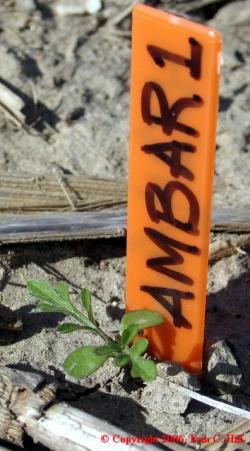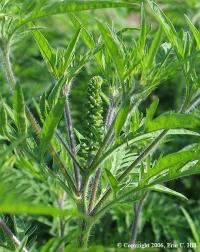Common ragweed
Common ragweed (Ambrosia artemisiifolia L.)

Life cycle:
Summer annual. Emerges in the spring sets seed in late summer/fall and dies.
Emergence:
Common ragweed is and early emerger, emerging relatively close to common lambsquarters. Ten percent emergence is seen between 150-300 GDD (base 48 deg. F); 50% emergence by 197 GDD (base 50); 80% emergence by 305 GDD (base 50).
High temperatures inhibit the germination of common ragweed.
Emerges from soil depths of 2 inches or less.
Seed:
Production Average: 3,500 seeds/plant
Dispersal Mechanisms: none
Longevity: The seed of common ragweed has very little to moderate persistance in the soil. It takes less than 1 year for the seed bank to be reduced by 50% and about 10 years for 99% depletion.
Dormancy: Common ragweed seed requires winter chilling (overwintering) to remove primary dormancy.
Competitiveness:
Common ragweed is one of the more competitive weed species. Ten to 22 percent yield loss in dry beans with one common ragweed plant per 1.5 ft of row. A 30% reduction in yield in soybean was observed from a common ragweed density of 2 plants per 10 ft^2.
Preferred Soil / Field Conditions:
This weed grows well on poorer soils. It does not thrive on soils high in N, P, or K.

Management:
Biological
Predation: Ground beetles (carabids) eat common ragweed seed that is lying on the soil surface.
Mechanical
Tillage: Tillage controls emerged common ragweed seedlings, but it also stimulates germination. Tillage at night (in the dark) reduces common ragweed germination and emergence by 45%.
Rotary hoeing: Common ragweed is easily controlled with a rotary hoe when less than 1/4".
Flaming: Flaming is not an effective method of controlling common ragweed.
Cultural
Crop rotation: Adding small grains to the rotation will help suppress common ragweed if they are overseeded with clover. Otherwise, common ragweed will grow and mature and produce seed in the small grain stubble. High crop seeding rates will also suppress common ragweed growth. Common ragweed does not tolerate mowing (including alfalfa in rotation).
Planting date: Tilling in the spring and planting later (mid-May) will reduce common ragweed infestations because many ragweed plants will have emerged and been controlled by tillage.
Chemical
Several herbicides are effective in controlling common ragweed in corn, soybean, sugar beets; few herbicides are available for control in dry beans. Populations resistant to certain classes f herbicides are known. Control with many herbicides is greater when common ragweed is small, less than 2 inches.



 Print
Print Email
Email